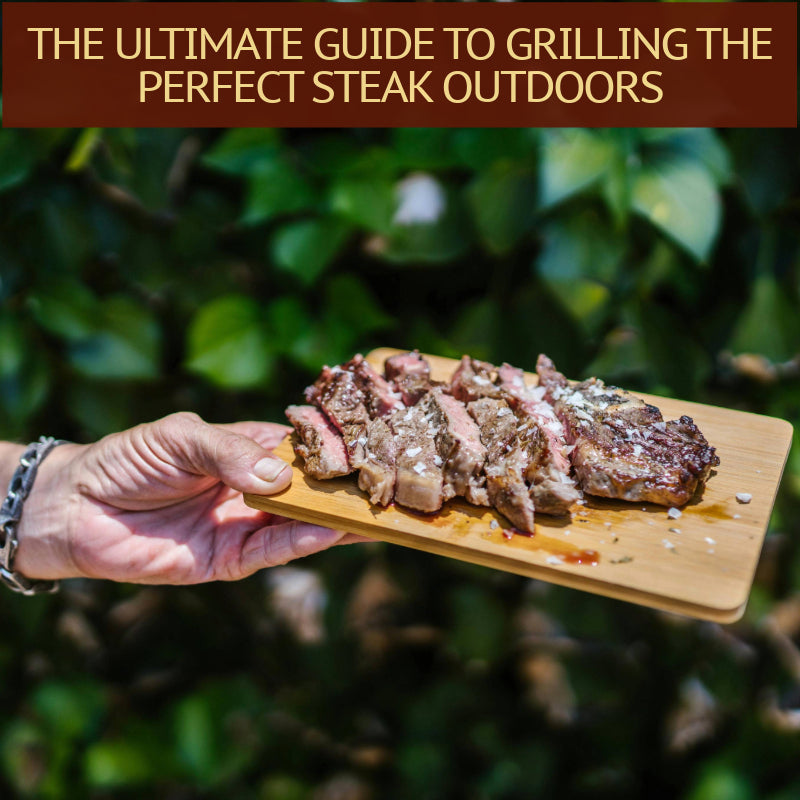Grilling a steak outdoors is more than just a cooking method—it’s an experience, a craft, and for many, an essential culinary skill. Achieving that perfect crust, juicy interior, and rich flavor requires knowledge, technique, and the right tools.
Whether you are a weekend warrior firing up the grill for a backyard cookout or a steak aficionado in pursuit of grilling perfection, this guide will provide you with everything you need to master the art of outdoor steak grilling.

Choosing the Right Cut: Quality Matters
The foundation of any great steak begins with selecting the right cut. Different cuts offer distinct textures, flavors, and levels of marbling, which all play a crucial role in how they cook on the grill. Understanding these differences can elevate your grilling game and ensure you choose the best steak for your desired result.
When considering options, marbling—the white flecks of fat within the meat—is a key indicator of flavor and tenderness. Cuts such as ribeye and New York strip are well-marbled and deliver a rich, buttery texture when grilled correctly. A ribeye provides a more pronounced beefy flavor with abundant fat, while a New York strip offers a firmer bite with balanced marbling.
Beyond marbling, thickness is another crucial factor. Ideally, a steak should be at least 1 to 1.5 inches thick to ensure a beautifully charred exterior while retaining a juicy interior. Thinner steaks tend to cook too quickly, making it challenging to achieve the perfect medium-rare or medium doneness without overcooking. Opting for high-quality, well-aged beef from reputable butchers or specialty meat providers also ensures superior flavor and tenderness.
Preparing Your Steak: Seasoning and Resting
Proper preparation before grilling can make the difference between an average and an exceptional steak. Seasoning, resting, and bringing your steak to the right temperature are all essential steps that should not be overlooked.
- Start by generously seasoning your steak with coarse salt and freshly ground black pepper. While simple, this classic seasoning combination enhances the beef’s natural flavors. For those who enjoy deeper complexity, a dry rub with garlic powder, smoked paprika, or a touch of cayenne can add additional layers of taste. If you prefer a marinade, keep it simple—olive oil, garlic, rosemary, and a splash of balsamic vinegar work well to complement the meat’s richness.
- Before grilling, allow the steak to rest at room temperature for about 30 to 45 minutes. This helps it cook more evenly, preventing the outside from overcooking before the interior reaches the desired doneness.
- Pat the steak dry with paper towels before placing it on the grill to ensure a perfect sear.
- Finally, brushing a light coat of high-smoke-point oil, such as avocado or grapeseed oil, can further prevent sticking and enhance browning.

Mastering the Grill Setup: Heat Zones and Fuel Choices
A well-prepared grill is just as important as the steak itself. Understanding heat zones, fuel choices, and proper grill maintenance ensures consistent results and optimal flavor development.
When grilling steak, it’s crucial to establish two heat zones—one side with direct high heat for searing and another with lower indirect heat for finishing the cooking process. This setup allows you to develop a flavorful crust while controlling doneness without burning the exterior. If you’re using a charcoal grill, arrange the coals to create a hot and cooler side. For gas grills, simply adjust the burners accordingly.
Choosing the right fuel also affects the taste of your steak. Charcoal grills impart a smoky depth, especially when using hardwood lump charcoal or adding wood chips like hickory or mesquite. Gas grills, while more convenient, offer precise temperature control and even heating. Whichever method you choose, ensuring your grill grates are clean and properly preheated is essential for achieving an even sear and preventing sticking.
Achieving the Perfect Sear: The Maillard Reaction
One of the hallmarks of an expertly grilled steak is a beautifully seared crust. This occurs due to the Maillard reaction, a chemical process where amino acids and reducing sugars react under high heat, producing complex flavors and a visually appealing brown crust.
To achieve this, place your steak on the hottest part of the grill and let it sear undisturbed for 3 to 5 minutes per side, depending on thickness. Avoid excessive flipping, as this prevents proper browning. Instead, allow the crust to form before turning. If flare-ups occur, move the steak to the indirect heat zone temporarily to prevent charring.
Using a cast-iron skillet on the grill can also intensify the searing effect. The skillet retains heat well and ensures even browning. Adding a small amount of butter or aromatics like crushed garlic and thyme during the last minute of searing can enhance the flavor and richness of the crust.

Managing Internal Temperature: Cooking to Perfection
The most accurate way to ensure your steak reaches the desired doneness is by using a meat thermometer. While visual cues and touch tests can be helpful, a thermometer eliminates guesswork and guarantees precision.
For a classic medium-rare steak, aim for an internal temperature of 130–135°F, while medium requires 140–145°F. Medium-well steaks should reach 150–155°F, and well-done steaks require 160°F and above. Always insert the thermometer into the thickest part of the steak, avoiding bone or fat pockets that could skew readings.
Once the steak reaches about 5°F below the target temperature, remove it from the grill and let it rest. Resting allows the juices to redistribute, ensuring a moist and flavorful bite. Cover the steak loosely with foil and let it rest for at least 5 to 10 minutes before slicing.
Serving and Pairing: Enhancing the Experience
The final steps of slicing and pairing can elevate your steak from great to extraordinary. Cutting against the grain—perpendicular to the muscle fibers—ensures tenderness, as it shortens the muscle strands, making each bite more enjoyable.
Complementing your steak with the right accompaniments enhances its flavor. Classic pairings include roasted garlic mashed potatoes, grilled asparagus, or a fresh arugula salad with balsamic glaze. A high-quality steak sauce or a simple compound butter with herbs and garlic can add another layer of richness.
For beverages, a full-bodied red wine, such as Cabernet Sauvignon or Malbec, pairs beautifully with grilled steak, as the tannins balance the richness of the meat. If you prefer beer, a robust porter or a hoppy IPA can complement the smoky flavors of the grill.

Final Thoughts: Perfecting Your Grilling Craft
Grilling the perfect steak outdoors is a combination of science, technique, and passion. From selecting the right cut to mastering the grill setup, searing, and achieving the ideal doneness, each step plays a crucial role in the final result.
By paying attention to details such as seasoning, heat management, and proper resting, you can elevate your steak-grilling skills and impress with restaurant-quality results in your own backyard.
With the right knowledge and practice, every steak you grill can be a masterpiece. So fire up the grill, enjoy the process, and savor the rewards of your culinary expertise.

